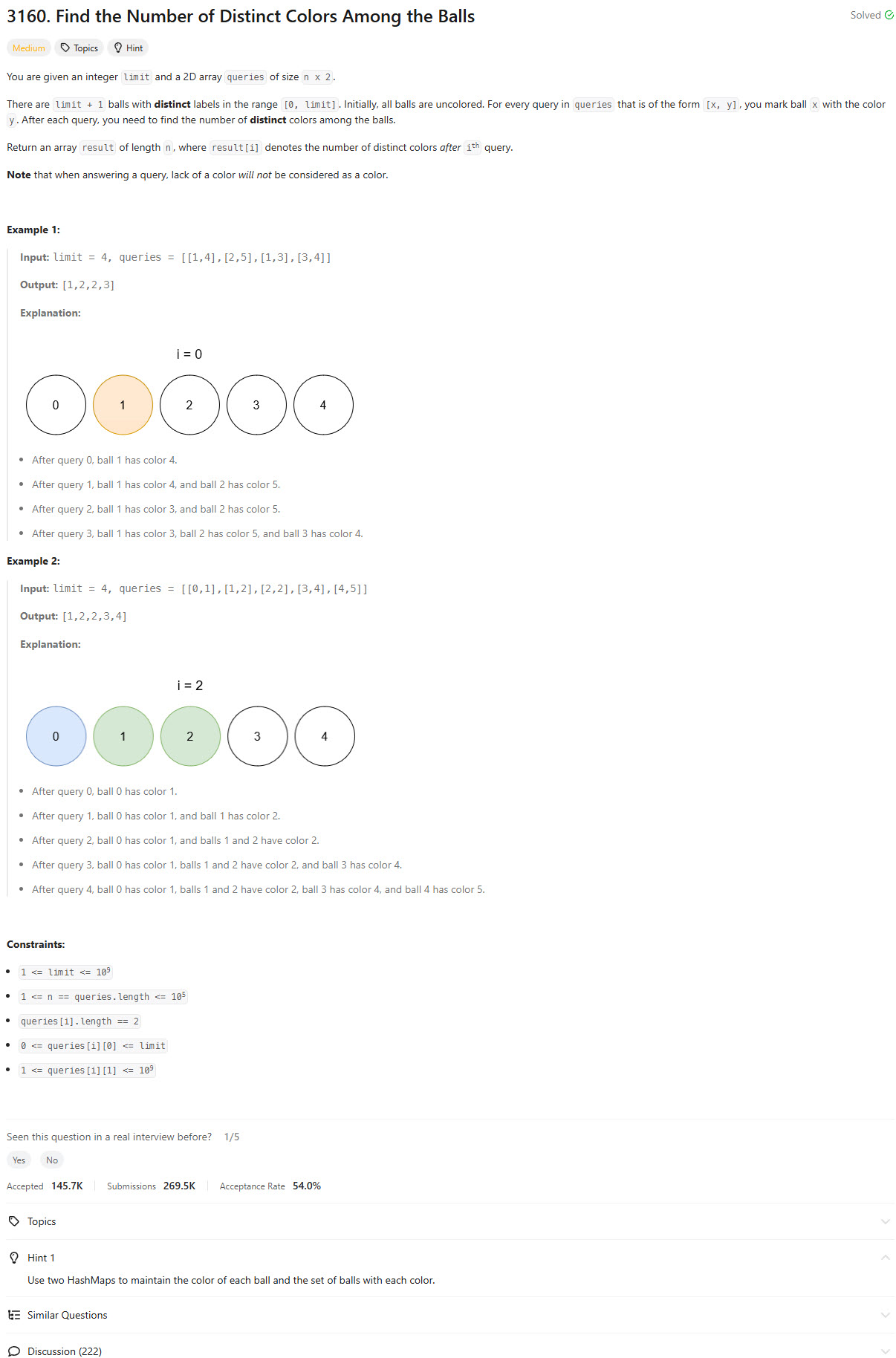Problem Statement

Brute Force [MLE]
class Solution:
def queryResults(self, limit: int, queries: List[List[int]]) -> List[int]:
N = len(queries)
arr = [None] * (limit + 1)
res = []
for x, y in queries:
arr[x] = y
res.append(len(set([val for val in arr if val is not None])))
return res
Hash Map Approach [TLE]
class Solution:
def queryResults(self, limit: int, queries: List[List[int]]) -> List[int]:
N = len(queries)
num_of_balls = limit + 1
colors = defaultdict(int)
res = []
for x, y in queries:
colors[x] = y
res.append(len(set(colors.values())))
return res
Improved Algorithm
class Solution:
def queryResults(self, limit: int, queries: List[List[int]]) -> List[int]:
colors = {} # Mapping of box -> color
color_freq = defaultdict(int) # Frequency of each color
unique_count = 0 # Count of unique colors
res = []
for x, y in queries:
if x in colors:
old_color = colors[x]
color_freq[old_color] -= 1
if color_freq[old_color] == 0:
unique_count -= 1 # If color count drops to 0, it's no longer unique
# Assign new color
colors[x] = y
if color_freq[y] == 0:
unique_count += 1 # If it's a new color, increase unique count
color_freq[y] += 1
res.append(unique_count)
return res
Editorial
Approach 1: Hashmap and Array
class Solution:
def queryResults(self, limit: int, queries: List[List[int]]) -> List[int]:
n = len(queries)
result = []
color_map = {}
ball_array = [0] * (limit + 1)
# Iterate through queries
for i in range(n):
# Extract ball label and color from query
ball, color = queries[i]
# Check if ball is already colored
if ball_array[ball] != 0:
# Decrement count of the previous color on the ball
prev_color = ball_array[ball]
color_map[prev_color] -= 1
# If there are no balls with previous color left, remove color from color map
if color_map[prev_color] == 0:
del color_map[prev_color]
# Set color of ball to the new color
ball_array[ball] = color
# Increment the count of the new color
color_map[color] = color_map.get(color, 0) + 1
result.append(len(color_map))
return result
Approach 2: Two Hash Maps
class Solution:
def queryResults(self, limit: int, queries: List[List[int]]) -> List[int]:
n = len(queries)
result = []
color_map = {}
ball_map = {}
# Iterate through queries
for i in range(n):
# Extract ball label and color from query
ball, color = queries[i]
# Check if ball is already colored
if ball in ball_map:
# Decrement count of the previous color on the ball
prev_color = ball_map[ball]
color_map[prev_color] -= 1
# If there are no balls with previous color left, remove color from color map
if color_map[prev_color] == 0:
del color_map[prev_color]
# Set color of ball to the new color
ball_map[ball] = color
# Increment the count of the new color
color_map[color] = color_map.get(color, 0) + 1
result.append(len(color_map))
return result
